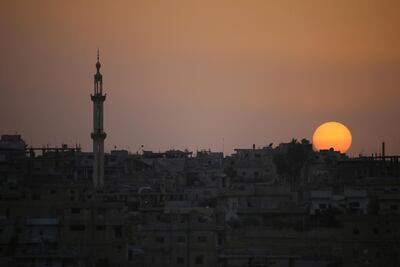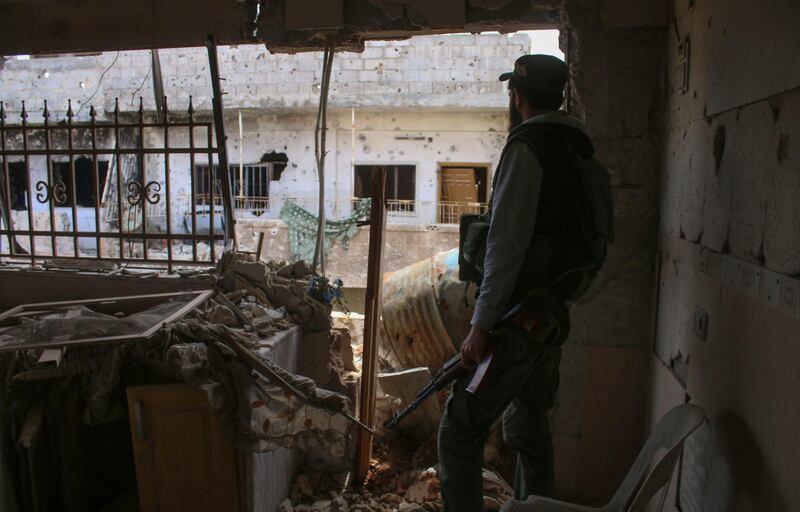The Syrian government is stepping up its campaign to reclaim the last remaining opposition-held territory in the country and will focus on two areas.
They are the Yarmouk refugee camp south of Damascus, where it began an operation against an ISIS tunnel network on Tuesday, and the southern city of Daraa, where rebels are preparing for an assault.
State TV said that government troops and allied forces were battling extremists in the last remaining area of the Syrian capital out of the regime's control. Other insurgents – some aligned with Al Qaeda – have agreed to move to rebel-held areas of northern Syria.
The fighting in Yarmouk has focused on the neighbourhood of Hajar Al Aswad, with the Syrian air force bombing the area and ISIS shelling government positions.
This week, UNRWA, the agency that cares for Palestinians, said 6,000 people had been displaced by the fighting into the neighbouring area of Yalda and called for safe passage for the sick and wounded civilians out of besieged areas of the camp.
"The injured and sick should be allowed to be evacuated," UNRWA spokesman Chris Gunness told The National. "Yarmouk has been transformed into a death camp, like one of the lower regions of Hell."

The Syrian Observatory for Human Rights, a pro-opposition war monitoring group based in the UK, said that since the fighting began last week, 15 troops and pro-government fighters and 19 ISIS terrorsist had been killed. It said dozens were wounded on both sides.
As that battle continued on Wednesday, rebels in the southern city of Daraa were preparing for a government offensive.
While the north-western province of Idlib is where many rebels and militants have moved after several deals to remove them from key Syrian cities, a victory for the regime in Daraa city would carry symbolic weight – it was the cradle of the 2011 uprising against President Bashar Al Assad's rule that precipitated a seven-year war.
On a tense urban frontline in Darra, rebels have reinforcied their defensive positions to ready for a assault by government troops.
Atallah Qutayfan, a 25-year-old fighter, spends his days stacking sandbags to shore up his post overlooking a market in the southern city, and monitoring his enemy nearby.
"Their reconnaissance planes are constantly above the city. There are daily clashes and they try to infiltrate our positions but we've stopped them," Mr Qutayfan told AFP.
“Our commanders told us to be ready for an attack by regime forces and we're on high alert.”
________________
Read more:
ISIS takes control of Damascus area after rebels pull out
At least 43 killed in one of the deadliest attacks in Damascus
ISIS 'executed' 116 in Syria town revenge campaign
________________
The city is split between rebels, who hold the southern Old City, and government forces who control the modern districts and government posts to the north.
Opposition forces still hold more than two thirds of the surrounding 3,730-square-kilometre province which borders Jordan.
But after the regime’s recent recapture of Eastern Ghouta, it can now focus its force more readily on Daraa.
“After Ghouta, the regime escalated its bombing against us with surface-to-surface missiles, machine-gun fire, mortars, tanks, and heavy artillery,” rebel fighter Fahed Abu Hatem said.
In response, Abu Hatem says, his forces reinforced their positions, dug trenches and erected more barricades.
The area, lying east of the rebel-held area of Quinetra that borders Israel, has a wider strategic importance in that it is part of a de-escalation zone agreed in May last year by rebel supporter Turkey and Al Assad allies Russia and Iran.
The US, Jordan and Russia have also supported the zone as an area for the cessation of hostilities.
Rebels inside Daraa say that it will not become another Ghouta, where a five-year siege resulted in a chemical attack that drew America, Britain and France into air strikes.
“The armed opposition here is holding it together,” Mohammad Al Masri, 60, a member of the local council, said.
“Here, the front lines are holding on. Our popular base and the rebels are in agreement: Daraa is our city, and we will stand firm in it.”






